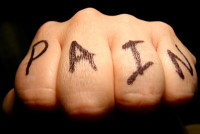Clean Pain, Dirty Pain

Clean Pain, Dirty Pain
Nobody likes pain. It makes sense that we make every attempt to avoid it or make it go away. But why do some of us seem to have less of it than others?
It may be helpful to sort our pain into two types: clean pain and dirty pain. It seems that we don’t have a whole lot of choice about our clean pain. We can avoid it as best we can but most people are going to have at least a bit of it. But where dirty pain is concerned, maybe we have more of a choice. Depending on how we react to the clean pain, we may or may not create large amounts of dirty pain in our lives.
At this point, you’re probably still wondering how to tell one type of pain from another. This does take a bit of practice, but the short answer is that clean pain is in the body whereas dirty pain is in the mind. If you can track your pain in specific areas of the body moment by moment (even if it’s emotional pain) then it’s probably pretty clean.
We start to experience clean pain on the very first day of our lives as we enter an unfamiliar world. As we develop, our experience expands from physical pain to emotional pain. And as we continue to grow and learn, our minds become very good at finding various ways to avoid pain. Our minds may try to protect us from clean pain by creating stories or defenses that provide a temporary solution. But these solutions usually don’t last and eventually the pain will recur. By following the path of least resistance, our minds employ old familiar strategies again and again, creating more and more dirty pain.
All of this is quite normal. Our minds are not our enemies. They happen to function a certain way and sometimes it serves us well, and at other times it creates problems. The move from dirty pain to clean pain is sometimes called acceptance, and it is basically a skill that can be learned. There are also some other skills that can really help with dirty pain, such as being present in the moment, getting disentangled from our thoughts, self-compassion, and committing to a clear set of values.
The first step is to do a basic check: Take an honest look at your current pain strategies and evaluate how well they are working for you. Include all kinds of pain, including emotional pain and even subtle forms of discomfort such as boredom and restlessness. If your current strategy is working well, that’s great. There is no need to fix something that isn’t broken. However, if like most of us you find that dirty pain is taking up a lot of time and energy, you might like to consider changing your whole relationship to pain. One way to do this is through Acceptance and Commitment Therapy, an evidence-based psychological therapy that I practice. Contact me to learn more.